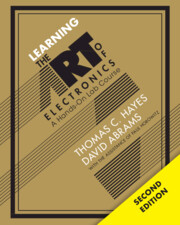Book contents
- Learning the Art of Electronics
- Learning the Art of Electronics
- Copyright page
- Dedication
- Contents
- Preface to the Second Edition
- Preface to the First Edition
- Overview, as the Course begins
- Part I Analog: Operational Amplifiers and their Applications
- 1N DC Circuits
- 1L Lab: DC Circuits
- 1S Supplementary Notes: Resistors, Voltage, Current
- 1W Worked Examples: DC circuits
- 1O Online Content: Breadboarding Hints & Tips
- 2N RC Circuits
- 2L Lab: Capacitors
- 2S Supplementary Notes: RC Circuits
- 2W Worked Examples: RC Circuits
- 3N Diode Circuits
- 3L Lab: Resonant and Diode Circuits
- 3S Supplementary Notes and Jargon: Diode Circuits
- 3W Worked Examples: Diode Circuits
- Part II Analog: Discrete Transistors
- Part III Analog: Operational Amplifiers and their Applications
- Part IV Digital: Gates, Flip-Flops, Counters, PLD, Memory
- Part V Digital: Analog–Digital, PLL, Digital Project Lab
- Part VI Microcontrollers
- Book part
- Index
1L - Lab: DC Circuits
from Part I - Analog: Operational Amplifiers and their Applications
Published online by Cambridge University Press: 18 March 2025
- Learning the Art of Electronics
- Learning the Art of Electronics
- Copyright page
- Dedication
- Contents
- Preface to the Second Edition
- Preface to the First Edition
- Overview, as the Course begins
- Part I Analog: Operational Amplifiers and their Applications
- 1N DC Circuits
- 1L Lab: DC Circuits
- 1S Supplementary Notes: Resistors, Voltage, Current
- 1W Worked Examples: DC circuits
- 1O Online Content: Breadboarding Hints & Tips
- 2N RC Circuits
- 2L Lab: Capacitors
- 2S Supplementary Notes: RC Circuits
- 2W Worked Examples: RC Circuits
- 3N Diode Circuits
- 3L Lab: Resonant and Diode Circuits
- 3S Supplementary Notes and Jargon: Diode Circuits
- 3W Worked Examples: Diode Circuits
- Part II Analog: Discrete Transistors
- Part III Analog: Operational Amplifiers and their Applications
- Part IV Digital: Gates, Flip-Flops, Counters, PLD, Memory
- Part V Digital: Analog–Digital, PLL, Digital Project Lab
- Part VI Microcontrollers
- Book part
- Index
Summary
The principal challenge here is simply to get used to the breadboard and the way to connect instruments to it. We do not expect you to find Ohm’s law surprising. Try to build your circuit on the breadboard, not in the air. Novices often begin by suspending a resistor between the jaws of alligator clips that run to power supply and meters. Try to do better: plug the two leads of the DUT (“Device Under Test”) into the plastic breadboard strip.
- Type
- Chapter
- Information
- Learning the Art of ElectronicsA Hands-On Lab Course, pp. 25 - 37Publisher: Cambridge University PressPrint publication year: 2025

